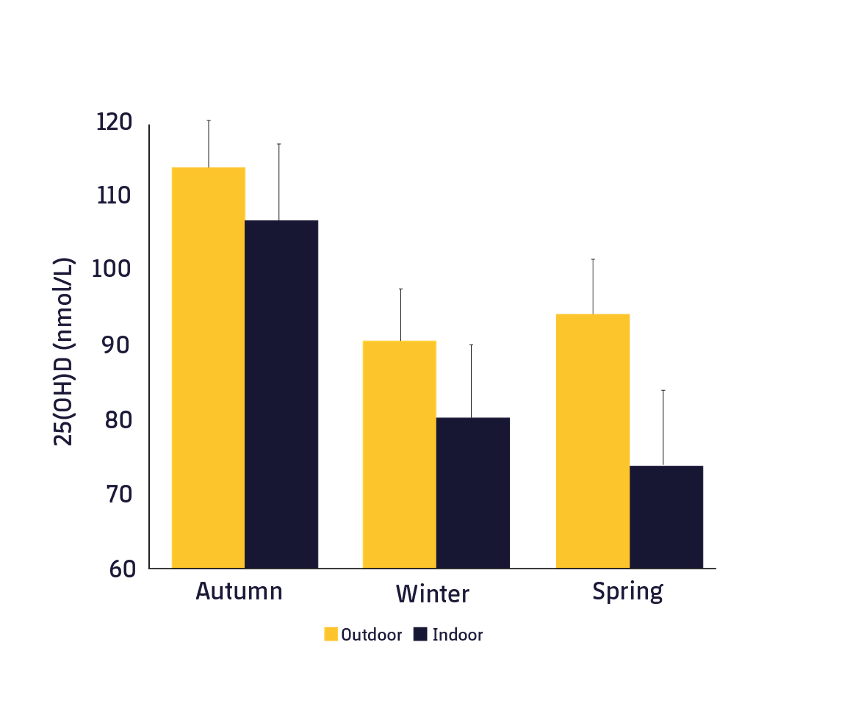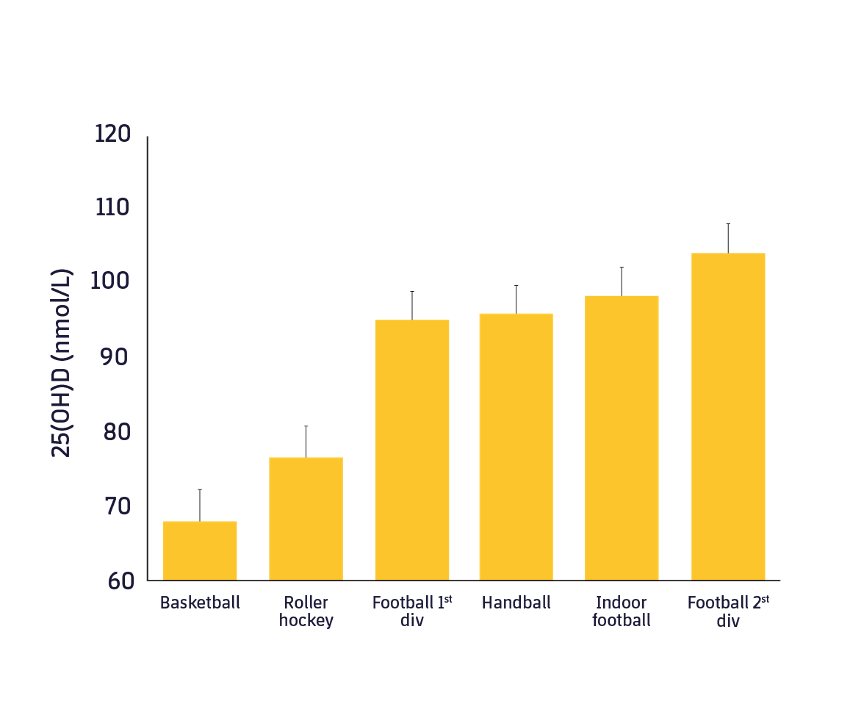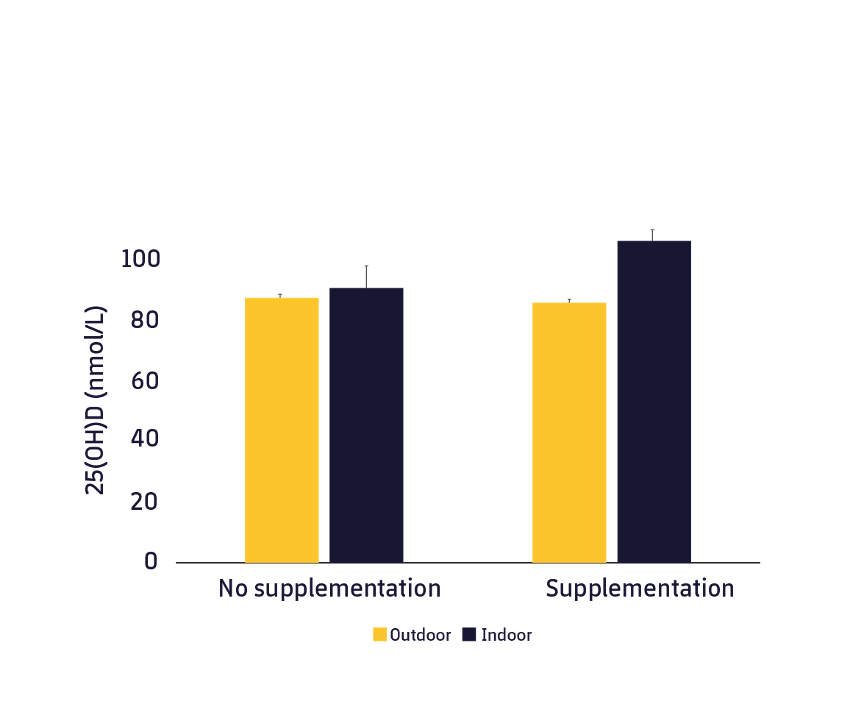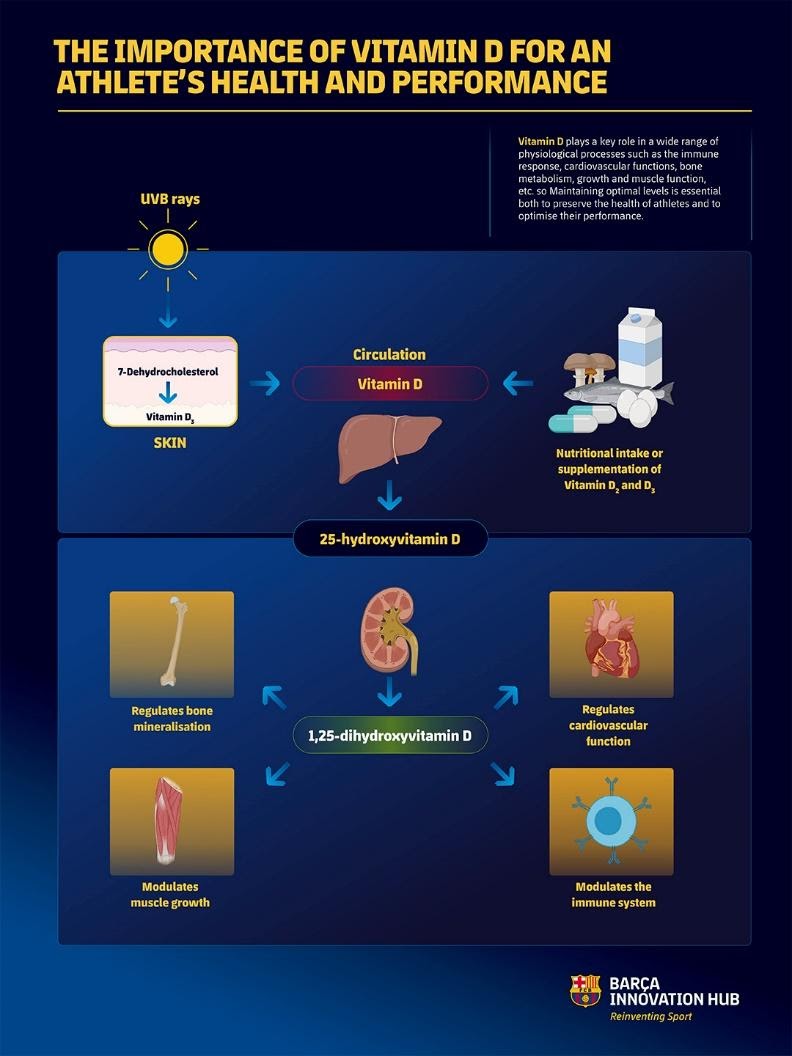Vitamin D is a fat-soluble vitamin that plays a fundamental role in physiological processes, such as immune response, cardiovascular function, bone metabolism, muscle function and growth.1,2 Therefore, maintaining adequate vitamin D levels is essential for athletes to stay healthy as well as to improve their performance. In fact, studies that have analysed muscle biopsies of patients with low vitamin D levels suggest that they suffer type II muscle fibre atrophy (also known as fast-twitch), which are crucial for the majority of athletes.3,4 Despite being relevant to health, the prevalence of insufficient vitamin D levels is common among people.4 In addition, even though there is not enough evidence, data suggest that vitamin D deficiency can also be common in elite sports’ athletes.5,6
Vitamin D is determined by measuring the person’s concentration levels of 25(OH)D, 125 nmol/L (50 ng/dL) being the optimal level for sports performance. Continually evaluating serum levels of vitamin D in athletes can help improve their performance due to the importance of vitamin D in the immune function, the protein synthesis and the muscle function and structure. Therefore, not only does vitamin D improve bone health but it also shows the person’s overall health.
In spite of its importance, the characteristics of high-performance sports, makes it difficult to conduct intervention studies; consequently, there is not enough information available concerning the vitamin D levels of elite athletes throughout a season. Members of the Medical Department at FC Barcelona have carried out a study assessing 95 athletes from different sports and divisions (22 athletes of the first division football team and 21 athletes of the second division, 12 from the futsal team, 12 from the basketball team, 17 from the handball team and 11 from the roller hockey team) throughout the 2011-2012 season, with the aim to study how the elite athletes’ vitamin D levels vary, and how the training environment (either indoor or outdoor training), the moment of the season and vitamin D supplements affect them.7
On average, the results demonstrated that the total concentration levels of 25(OH)D were ~92 nmol/L in all athletes, with higher levels in players who took supplements (~95 nmol/L) and in those who trained outdoors (~100 nmol/L). It should be noted that around 25% of athletes presented levels lower than 75 nmol/L; but no athlete showed levels under 50 nmol/L.
How does outdoor training, the season and supplements affect vitamin D levels?
Seasonality greatly affected vitamin D levels as higher levels of vitamin D were observed in autumn, in comparison with those of winter and spring. The higher vitamin D level rate, under 75 nmol/L, was observed in spring (40% of athletes), followed by 35% in winter and 10% in autumn (Figure 1).

Moreover, there were differences in the average concentration levels of 25(OH)D per sport modality and supplementation over the course of the year. Throughout the year, the highest vitamin D levels were observed in football players, especially in those who played in the second division and took supplements all year round, while the lower concentrations were found in basketball players (Figure 2). With regard to supplementation, athletes from the roller hockey team, futsal team and football team of the second division took supplements all year round. On the other hand, only ~6% of handball players, ~27% of football players of the first division and around 60% of basketball players took supplements. Hence, players that took supplements generally had higher vitamin D levels than the ones that did not take any. Therefore, according to these results, the season and supplementation are believed to affect vitamin D levels in professional athletes.

The environment also affected the levels of 25(OH)D. Those athletes who played or trained outdoors had higher vitamin D levels (105 nmol/L) than the ones that trained indoors, regardless of whether they took supplements or not, (85 nmol/L). This shows that training outdoors and taking vitamin D supplements can increase vitamin D levels (Figure 3).

Mainly, the skin synthesizes vitamin D due to exposure to UVB radiation, but lower vitamin D levels can be found in spite of being sufficiently exposed to the sun,8 which would require diet changes in order to increase vitamin D intake. So, what foods are rich in vitamin D? Oily fish such as salmon, mushrooms, and dairy products, such as milk and cheese. Besides increasing the consumption of foods rich in vitamin D, its supplementation, as it is suggested in this research study, could also play a key role in elite players. Thus, the combination of a high vitamin D intake and radiation exposure (with caution) is needed in order to reach the necessary vitamin D levels, especially in elite players, even though the correct dose should be analysed and administered according to each player (Figure 4).

Conclusions
Vitamin D is fundamental for bone health, immune function and muscle function and structure. Therefore, in high-performance sports, boosting vitamin D levels (125nM/L or 50ng/ dL) can help improve the athletes’ health and performance. As it is suggested in this research study, around 1 out of 4 players face the risk of suffering hypovitaminosis D. Thus, the season of the year, outdoor training and supplementation seem to be factors that significantly boost vitamin D levels.
Consequently, the authors of the research study recommend regular and safe sun exposure, together with an outdoor training (whenever possible) as well as dietary supplements combined with a more increased intake of foods rich in vitamin D.
Adrián Castillo
References:
- Hamilton, B. Vitamin D and Human Skeletal Muscle. Scand. J. Med. Sci. Sports 20, 182–190 (2010).
- Zhang, R. & Naughton, D. P. Vitamin D in health and disease: Current perspectives. Nutr. J. 9, 65 (2010).
- Bartoszewska, M., Kamboj, M. & Patel, D. R. Vitamin D, Muscle Function, and Exercise Performance. Pediatr. Clin. North Am. 57, 849–861 (2010).
- Villacis, D. et al. Prevalence of Abnormal Vitamin D Levels Among Division I NCAA Athletes. Sports Health 6, 340–347 (2014).
- Lovell, G. Vitamin D Status of Females in an Elite Gymnastics Program. Clin. J. Sport Med. 18, (2008).
- Morton, J. P. et al. Seasonal variation in vitamin D status in professional soccer players of the English Premier League. Appl. Physiol. Nutr. Metab. 37, 798–802 (2012).
- Valtueña, J. et al. Vitamin D Status in Spanish Elite Team Sport Players. Nutrients vol. 13 (2021).
- Hamilton, B., Grantham, J., Racinais, S. & Chalabi, H. Vitamin D deficiency is endemic in Middle Eastern sportsmen. Public Health Nutr. 13, 1528–1534 (2010).
KNOW MORE
CATEGORY: MARKETING, COMMUNICATION AND MANAGEMENT
This model looks to the future with the requirements and demands of a new era of stadiums, directed toward improving and fulfilling the experiences of fans and spectators, remembering “feeling” and “passion” when designing their business model.
CATEGORY: FOOTBALL SPORTS PERFORMANCE
Through the use of computer vision we can identify some shortcomings in the body orientation of players in different game situations.
CATEGORY: MEDICINE HEALTH AND WELLNESS
A health check must detect situations which, despite not showing obvious symptoms, may endanger athletes subject to the highest demands.
CATEGORY: FOOTBALL TEAM SPORTS
In the words of Johan Cruyff, “Players, in reality, have the ball for 3 minutes, on average. So, the most important thing is: what do you do during those 87 minutes when you do not have the ball? That is what determines whether you’re a good player or not.”
CATEGORY: MEDICINE HEALTH AND WELLNESS SPORTS PERFORMANCE
Muscle injuries account for more than 30% of all injuries in sports like soccer. Their significance is therefore enormous in terms of training sessions and lost game time.
DO YOU WANT TO KNOW MORE?
- SUBSCRIBE
- CONTACT
- APPLY
KEEP UP TO DATE WITH OUR NEWS
Do you have any questions about Barça Universitas?
- Startup
- Research Center
- Corporate